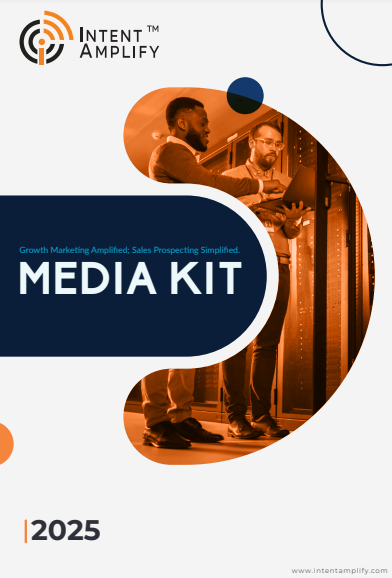
What Is a Lead Magnet? And How to Create One That Converts
- Last updated on: August 4, 2025
No one wakes up thinking, “I can’t wait to download another boring PDF today.” And that’s exactly what most B2B lead magnets feel: dull, generic, and easily forgettable. But a great lead magnet? It’s a game-changer.
It grabs your prospect’s attention, solves a real problem, and makes them think, “Okay, these folks get it.” It’s not about tricking someone into giving their email – it’s about offering something so valuable, they’re happy to hit “submit.” In this article, learn what a lead magnet is, why most of them donot work, and how to build one that does what it’s supposed to do: generate leads that turn into business.
What Is a Lead Magnet?
At Intent Amplify, we define a lead magnet as a value-packed resource offered to prospects in exchange for their contact information – usually through a form. It’s intended to attract your target customer by addressing a specific issue, answering an urgent query, or providing a shortcut to success. The most effective lead magnets offer two things:
- Provide immediate, tangible value to the user.
- Qualify the lead for future sales conversations.
Lead magnets, unlike blog articles and social media material, are often gated. They sit behind a form, and in exchange for access, you acquire a new contact, frequently with information such as industry, job title, or firm size. This makes them one of the most strategic weapons in the B2B marketing toolbox.
Why Are Lead Magnets Important for B2B Lead Generation?
In B2B, every download is a signal. It shows intent, curiosity, or a problem that needs solving. And unlike cold outreach, a lead magnet brings the prospect to you – voluntarily. 78% of decision-makers say that the credibility and professional authority of a lead magnet directly influence whether they’re willing to share their contact information.
Here’s why lead magnets are mission-critical:
- They build trust early: Sharing valuable insights positions your brand as a helpful expert, not just a seller.
- They qualify leads: The content of the lead magnet can reveal the user’s role, stage in the funnel, or pain point.
- They create momentum: A strong magnet can serve as the entry point into a well-sequenced nurture journey or sales conversation.
- They improve conversion rates: Visitors are far more likely to submit a form for something useful than for a “Contact Us” button.
In short, a well-designed lead magnet isn’t just about growing your email list – it’s about generating leads that move your pipeline forward.
9 High-Converting B2B Lead Magnet Formats for 2025
Not all lead magnets are the same. In 2025, decision-makers are busier, smarter, and less likely to give away their email for generic content. These are nine formats that have been proven to convert in B2B:
1. ROI Calculators – These interactive resources allow customers to estimate the possible payback from applying your product or service. Great for CFOs or procurement leaders considering investment justification.
2. Playbooks and Frameworks – Provide a strategic, repeatable process such as a “6-Step Lead Nurturing Framework.” Great for mid-funnel buyers in need of advice.
3. Benchmark Reports – Original research or data contrasting industry norms establishes your brand as an expert. Excellent for C-level executives and analysts.
4. Ready-to-Use Templates – From copy for email to call scripts, they save time and effort for your audience. They’re unbeatable when customized by job role or industry.
5. Scorecards and Assessments – Allow users to measure their performance with a quiz or downloadable scorecard. It’s engaging, helpful, and qualifies the lead based on their score.
6. Comparison Guides – Make buyers’ decisions easier by providing vendor comparison sheets, price breakdowns, or solution matrices.
7. Case Study Collections – A collection of real-life success stories can deliver strong social proof – particularly when focused on a vertical or use case.
8. Interactive Tools – Consider audit tools, configurators, or onboarding checklists. These deliver utility and data you can take action upon.
9. Micro-Courses or Drip Emails – Bite-sized education sequences that assist in buyers’ learning at their own pace and create long-term engagement.
The takeaway: the best lead magnets address one precise issue very well.
How to Create a Lead Magnet That Converts?
Here is the step-by-step process to build a high-performing lead magnet:
1. Know Your Buyer Inside Out
“Make the customer the hero of your story.” — Ann Handley
What keeps them up at night? What quick wins are they chasing? Your magnet must answer a specific question that your ICP (Ideal Customer Profile) is actively trying to solve.
2. Choose the Right Format for the Funnel Stage
Top-of-funnel? Go with educational content like templates or reports. Mid-funnel? Try comparison guides or calculators. Bottom-funnel? Offer demos, consultations, or trials.
3. Nail the Title
Your title is your hook. It must be specific, benefit-driven, and outcome-focused. Examples:
- “The Ultimate B2B Marketing Guide”
- “3 Proven Templates to Book More B2B Sales Meetings”
4. Make the Value Immediate
Don’t bury the good stuff. Whether it’s a downloadable template or a scoring tool, your user should get value in the first 3 minutes.
5. Keep the Form Simple
Don’t ask for more information than you need. If you’re not going to personalize follow-ups based on company size, don’t ask for it.
6. Create a Follow-Up Journey
A download is only the beginning. Trigger automated emails that reinforce value, provide related content, and eventually offer your solution.
Mistakes to Avoid When Creating Lead Magnets
Even good intentions can lead to poor results. Here are common mistakes that can ruin your lead magnet’s performance:
- Being too generic: “Ultimate Guides” that try to cover everything often connect with no one. Niche content performs better.
- Using it as a brochure: Your lead magnet should solve a problem – not pitch your product. Save the sale for later.
- Not aligning with buyer stage: Offering a free trial to a top-of-funnel visitor rarely works.
- Making forms too long: Friction kills conversions. Stick to 3–4 fields max unless you have a firm offer.
- Skipping follow-up: A download without nurturing is a dead-end. Always connect your lead magnet to a drip campaign or sales touch.
How to Promote Your Lead Magnet?
Creating a valuable lead magnet is step one – getting it in front of your audience is step two. Here’s how:
Organic Strategies
- Embed in blog posts: Add the magnet inside related blog content as a CTA.
- Use in LinkedIn posts: Share previews, takeaways, or interactive components to drive downloads.
- Add to your homepage or nav: Make it visible site-wide.
- Use smart popups or exit intent: Offer the lead magnet when users are most likely to bounce.
Paid Strategies
- LinkedIn Ads: Target job titles, industries, and company sizes with high intent.
- Google Ads: Bid on solution-based keywords and direct to a gated landing page.
- Retargeting Campaigns: Show your lead magnet to visitors who didn’t convert on their first visit.
Pro tip: Don’t just promote the asset, promote the outcome it delivers.
When Should You Refresh a Lead Magnet?
Even high-performing lead magnets lose steam over time. Here’s when to refresh:
- Performance drops: If conversions fall or engagement drops, update content, title, or format.
- Buyer needs change: Stay aligned with new pain points, trends, or competitor activity.
- Your positioning evolves: Update visuals and copy to match your brand tone and strategy.
- Repurpose top content: Turn a report into an infographic, webinar, or video series.
You don’t always need to start from scratch – optimize first.
Lead Magnets Are Trust Builders
A lead magnet is your first promise to a potential buyer. If it delivers value, they’ll trust you with their next step. If it falls flat, they’ll bounce, and you may not get a second chance.
In B2B, conversion isn’t about tricks. It’s about relevance, clarity, and trust. At Intent Amplify, we help growth-stage B2B companies turn their outreach and appointment-setting into a high-performing engine – powered by smart lead generation assets. Build lead magnets that generate real meetings
FAQs
1. What is the ideal length for a lead magnet?
It depends on the format. Templates and checklists should be short and usable. Reports or guides can be longer, just make sure the value is clear upfront.
2. Should I always gate my lead magnets?
No. Gate high-value content that attracts high-intent leads. For broader awareness pieces, consider ungated or soft-gated formats.
3. What’s the best platform to host lead magnets?
You can host them on your CMS, landing page builders like Unbounce, or integrate with CRMs like HubSpot or Marketo for automation.
4. How often should I create new lead magnets?
Aim to release a new one quarterly, based on new campaigns, updated ICP insights, or product messaging shifts.
5. Can AI help create lead magnets?
Yes. Tools like ChatGPT can help outline, write, and personalize lead magnet content—but always refine with a human lens.




